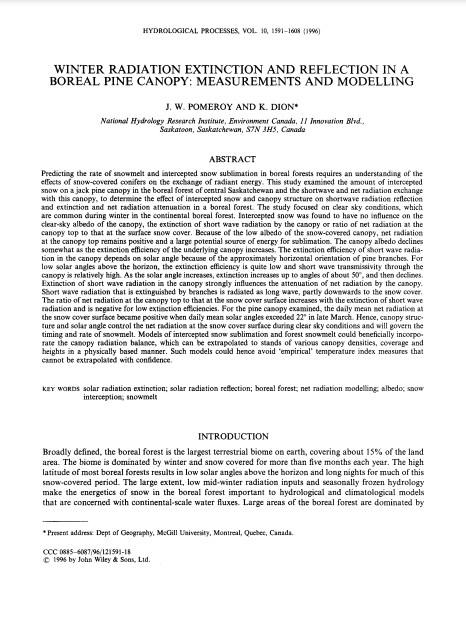Winter radiation extinction and reflection in a boreal pine canopy: Measurements and modelling
Bosque Modelo:
Prince Albert
Temática:
Desarrollo humano
Tipo de documento:
Artículo científico
Resumen
Predicting the rate of snowmelt and intercepted snow sublimation in boreal forests requires an understanding of the effects of snow-covered conifers on the exchange of radiant energy. This study examined the amount of intercepted snow on a jack pine canopy in the boreal forest of central Saskatchewan and the shortwave and net radiation exchange with this canopy, to determine the effect of intercepted snow and canopy structure on shortwave radiation reflection and extinction and net radiation attenuation in a boreal forest. The study focused on clear sky conditions, which are common during winter in the continental boreal forest. Intercepted snow was found to have no influence on the clear-sky albedo of the canopy, the extinction of short wave radiation by the canopy or ratio of net radiation at the canopy top to that at the surface snow cover. Because of the low albedo of the snow-covered canopy, net radiation at the canopy top remains positive and a large potential source of energy for sublimation. The canopy albedo declines somewhat as the extinction efficiency of the underlying canopy increases. The extinction efficiency of short wave radiation in the canopy depends on solar angle because of the approximately horizontal orientation of pine branches. For low solar angles above the horizon, the extinction efficiency is quite low and short wave transmissivity through the canopy is relatively high. As the solar angle increases, extinction increases up to angles of about 50", and then declines. Extinction of short wave radiation in the canopy strongly influences the attenuation of net radiation by the canopy. Short wave radiation that is extinguished by branches is radiated as long wave, partly downwards to the snow cover. The ratio of net radiation at the canopy top to that at the snow cover surface increases with the extinction of short wave radiation and is negative for low extinction efficiencies. For the pine canopy examined, the daily mean net radiation at the snow cover surface became positive when daily mean solar angles exceeded 22" in late March. Hence, canopy structure and solar angle control the net radiation at the snow cover surface during clear sky conditions and will govern the timing and rate of snowmelt. Models of intercepted snow sublimation and forest snowmelt could beneficially incorporate the canopy radiation balance, which can be extrapolated to stands of various canopy densities, coverage and heights in a physically based manner. Such models could hence avoid 'empirical' temperature index measures that cannot be extrapolated with confidence.
Información Bibliográfica
Autor:
Pomeroy, JW and K Dion.
Revista:
Hydrological Processes
Año:
1996
N°:
12
País :
Canadá
Páginas:
1591 - 1608
Volumen:
10
Idioma:
Ingles
Palabras claves
solar radiation extinction; solar radiation reflection; boreal forest; net radiation modelling; albedo; snow interception; snowmelt





